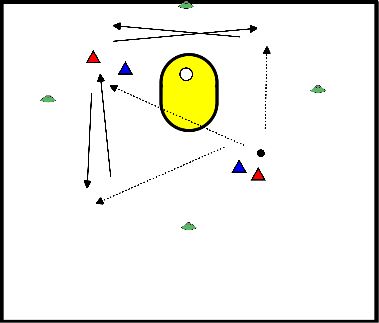Korfball drills for technique passing / attack
- One ball per pair/three.
- Players throw across until they reach a pole.
- At the pole, both players may shoot once.
- Then they must again throw over to another pole.
- All groups just go right through each other.
- Whichever two/three has 15 goals (optional) first.
- One ball per pair/three.
- Players throw across until they reach a pole.
- At the pole, both players may shoot once.
- Then they must again throw over to another pole.
- All groups just go right through each other.
- Whichever two/three has 15 goals (optional) first.
One 3 per pole. The exercises must be done at 100%. Each exercise lasts 2.5 minutes. The intermediate exercises take a specific time. The goal is to generate the most goals as a group.
- Shots in front of the basket from 6 meters where the shooter gets a repeat shot then switch.
- (intermediate assignment 1: 25 push-ups)
- Walk-through balls from 10 meters on the front and back of the post.
- (Intermediate assignment 2: 30 sit-ups)
- Short chances, If the ball falls to the ground you start again at 0.
- (Intermediate assignment 3: 3-on-3 game where you can choose a basket as the attacking side)
- 4-side shooting from movement at 5 meters.
- (intermediate assignment 4: 15 burpees)
- Dodging ball with the obligation to make a through ball when passing in through the ground. Player is played the ball, plays in on the pass, makes a dodge ball, is played the ball and plays in via a pass on the ground and makes a through ball.
- (Intermediate task 5: 3 against 3 in which only finishing is allowed by means of a shot).
- Shots back of the basket from 6/7 meters with repeat shot.
- One 3 per pole.
- The exercises must be done at 100%.
- Each exercise lasts 2.5 minutes.
- The intermediate exercises take a specific time.
- The goal is to generate the most goals as a group.
Exercise 1:
Shots front of the basket from 6 meters where the shooter gets a repeat shot, then switch through
Shots front of the basket from 6 meters where the shooter gets a repeat shot, then switch through
Intermediate assignment 1:
20 burpees and 20 out-ups
Exercise 2:
Walk-through balls from 10 meters on the back of the post.
Intermediate assignment 2:
group 1 against 2 and group 3 against 4. 3 against 3 where no takeover is allowed, if scored then you may continue. The goals scored count double.
Exercise 3:
2 players under the basket, 1 in front of the basket.
The ball is thrown from the front of the post to the player pulling away. then shot. The ball is played from the post to the player who shot. Then a player pulls away from the basket, gets the ball and shoots.
Intermediate assignment 3: Jumping jacks 2.5 minutes
Exercise 4:
Shots at the back of the basket from at least 6 meters where the shooter gets a repeat shot.
Intermediate assignment 4:
group 1 against 3 and group 2 against 4. 3 against 3 where no takeover is allowed, if scored then you may continue. The goals scored count double.
Exercise 5:
Make penalty throws. Each player makes 4 penalty throws in a row, then continue the game.
Intermediate exercise 5: Wall sit and plank
Exercise 6:
2 players in the attack box, 1 person rebound/handover.
1st ball is always from the handover to one of the outside players. A rebound follows. Immediately the 1st player runs deep. Cross ball which is immediately played in for the through ball. The rebounder joins the remaining attacking player.
20 burpees and 20 out-ups
Exercise 2:
Walk-through balls from 10 meters on the back of the post.
Intermediate assignment 2:
group 1 against 2 and group 3 against 4. 3 against 3 where no takeover is allowed, if scored then you may continue. The goals scored count double.
Exercise 3:
2 players under the basket, 1 in front of the basket.
The ball is thrown from the front of the post to the player pulling away. then shot. The ball is played from the post to the player who shot. Then a player pulls away from the basket, gets the ball and shoots.
Intermediate assignment 3: Jumping jacks 2.5 minutes
Exercise 4:
Shots at the back of the basket from at least 6 meters where the shooter gets a repeat shot.
Intermediate assignment 4:
group 1 against 3 and group 2 against 4. 3 against 3 where no takeover is allowed, if scored then you may continue. The goals scored count double.
Exercise 5:
Make penalty throws. Each player makes 4 penalty throws in a row, then continue the game.
Intermediate exercise 5: Wall sit and plank
Exercise 6:
2 players in the attack box, 1 person rebound/handover.
1st ball is always from the handover to one of the outside players. A rebound follows. Immediately the 1st player runs deep. Cross ball which is immediately played in for the through ball. The rebounder joins the remaining attacking player.
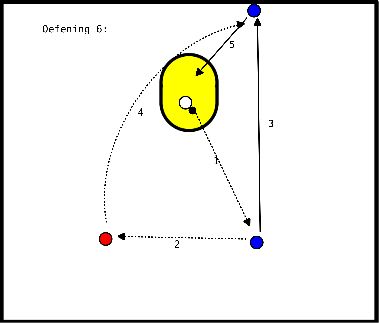
- Make pairs
- Place 3 pawns in a triangle, about 4 meters apart
- Players stand at pawns 1 and 3
- Player at pawn 1 has a ball
Progression:
- Player at pion 3 runs to pion 2 taps him and runs back.
- The player at pion 1 throws the ball before player 2 arrives at the pion, so that the ball is given in the run.
- When the ball arrives at player 2 then player 1 at pion 1 runs to pion 2 and the player at pion 1 runs to pion 2 and back.
- Gets the ball passed in the run when she/he arrives at pion 1 again.
- Then player 2 starts again.
More difficult:
Throwing with the other hand.
Variation:
Throwing with the other hand.
Variation:
- player 1 at pawn 1 and player 2 at pawn 3.
- player 1 runs to pawn 2 and player 2 throws the ball in the run to player 1.
- After throwing the ball, player 2 runs directly to pawn 1 and receives the ball in the run from player 1.
- Player 1 then runs towards the free pawn again and so on.
- When the trainer calls yes, the players turn the other way.
- Make sure they keep throwing with the outside hand.
- Put 3 pawns in a triangle, with about 4 meters apart
- At pawns 1 and 3, one person stands.
- The player at pawn 1 has the ball.
- The player at pion 3 runs to pion 2, taps it and runs back.
- The player at pawn 1 throws the ball to player 2 before he is back at the 3rd pawn.
- Thus the ball is given in the run.
- When the ball arrives at player 2, player 1 then runs to pawn 2 and back again in which he then gets the ball passed by player 2 in the run.
- The ball is played in to a high support and the inspeler threatens to pass.
- The support shifts the ball to the side or back of the basket, onto a moving player.
- The player behind the basket takes a shot.
- The inspeler comes over the support and catches the ball.
- The catcher plays the ball forward to the runaway support.
- The shooter assumes the support position and the interceptor becomes the new shooter.
This exercise can be played from any side.
The goal of the exercise is to use the whole field and create space in the game.
The goal of the exercise is to use the whole field and create space in the game.
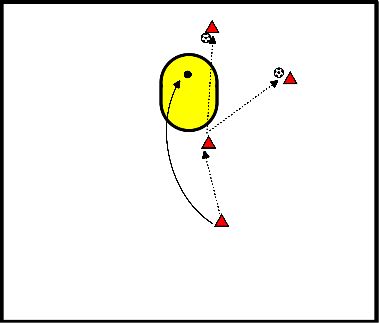
- The player behind the basket plays the ball sideways and briefly moves back and forth in the broadside line.
- Simultaneously with the play-in, the forward player comes to the basket and makes a through ball.
- The first player catches the ball and places the ball out toward the pass-through shooter.
- The catcher takes the place of the declarer and the declarer becomes the shooter.
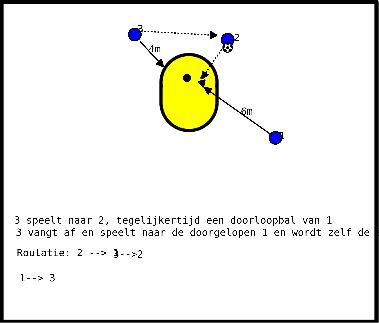
- The forwards player plays the ball into the support and runs towards the support.
- The support plays the ball to the fellow attacker coming in from the side just before the striker reaches him.
- The striker runs around the support and receives the ball from the fellow attacker and takes a through ball.
- The shooter catches the ball himself and places it forward.
- The support becomes a through-ball.
- The co-attacker support.
- The shooter becomes co-attacker.
Score 20 times over left and 20 times over right.
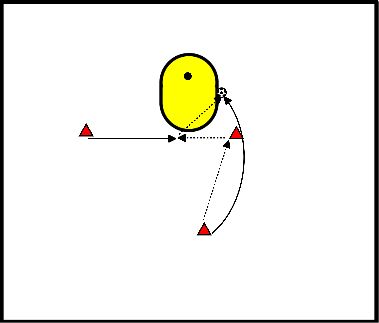
- In this exercise you use 2 poles facing each other.
- At each pole there is a declarer.
- One of the attackers has the ball.
- The posts are +/- 10 meters apart.
- At about 4 meters from the basket on the side stands an attacker with a defender.
- The attacker goes to the side of the post to make an offensive move to receive the ball for the shot.
- The goal is for the defender to give so much pressure that the ball cannot be thrown. If this happens the attacker makes a running action to the other post.
- The one standing in support throws the ball. the attacker must first make a rebound and only then make the through ball.
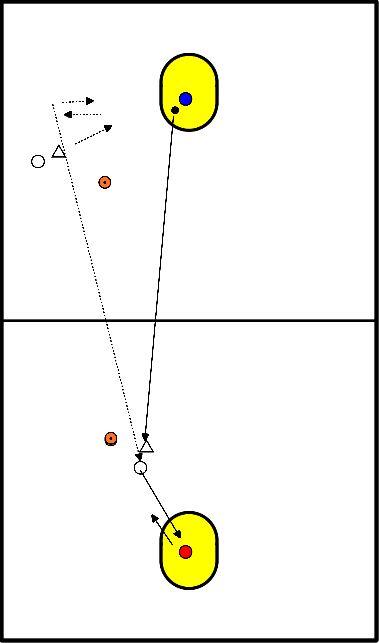
- Player A plays to B.
- B places through on the to the side running out C.
- C plays through to the to the tip of the circle running in on D and C threatens in.
- B, after the pass to C, runs around C to the basket and gets the through ball indicated by D.
- A, meanwhile, has run to the backcourt to replenish if needed.
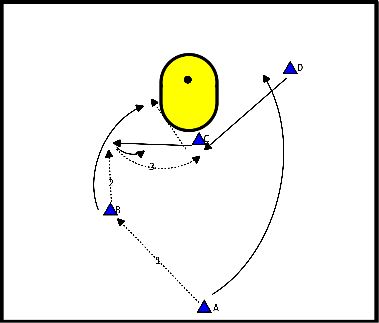
Goal: as a player to free your fellow players after a long line.
- The pole is the central point.
- The playing field is divided into 4 squares.
- If the player can pass to someone diagonally, do so after long runs.
Points:
- Scoring from pass wide = 1p
- Scoring from diagonal = 2p
- Hitting basket from diagonal = 1p
- Passer without a defender
- Attacker without defender
- Both with defender; 2 against 2
